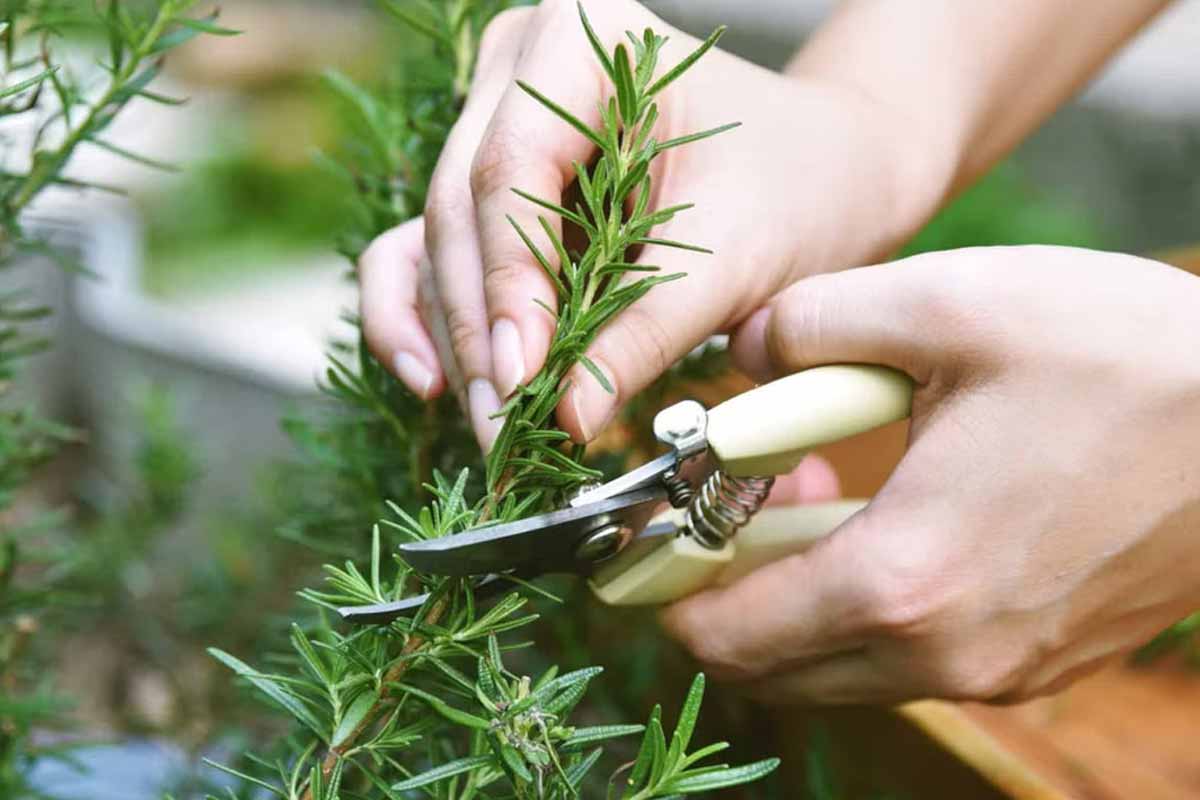One careful snip can turn a modest shrub into a dependable kitchen ally. Shape it with purpose, and the plant answers with stronger shoots and cleaner lines. Flavor holds through heat and time when growth stays balanced. Cut above leaf nodes, keep volume in check, and choose sturdy, green-tipped stems. With late-morning timing and clean, sharp tools, rosemary keeps pushing fresh tips for frequent harvests. Your plant stays vigorous, compact, and beautifully aromatic.
Cutting Basics That Protect Plant Vigor
A flourishing plant begins with maturity, structure, and light. When rosemary achieves establishment—often by the second growing season—its lower stems feel woody while the tips remain green and tender. That contrast signals readiness. New shoots respond quickly to clean cuts, so growth fills in while sunlight reaches interior leaves, which maintains energy and shape.
Where the scissors meet the stem matters because branching begins at the leaf node. Make each snip just above a node so dormant buds wake and split into two shoots. This simple choice builds a dense canopy, adds airflow, and keeps the shrub compact, which limits leggy growth while supporting lasting productivity indoors or outside.
Length gives guidance, too. Select healthy, mature stems at minimum six inches long so the plant retains sufficient leaf surface for photosynthesis. Short, weak shoots stagnate after cutting, while robust sprigs recover. Strong stems also handle cooking better, because their needles hold texture in heat, then release oils steadily in marinades and roasts.
Tools and Timing for Harvesting rosemary Safely
Carry only what helps: pruning shears for clean cuts, optional gloves for grip, and a harvest basket that prevents crushing. Stainless blades slice cleanly, which reduces tissue damage and disease risk. After each session, wipe tools so sap does not gum hinges, because smooth action matters when you’re trimming a lot of sprigs fast.
Start by selecting stems that meet the six-inch target. Cut just above a leaf node, then set sprigs gently in the basket. Check foliage as you go. Remove any damaged or pest-marked parts so remaining shoots channel energy into new tips. According to Vanessa Dawson, this cleanup encourages vigorous, even regrowth across the canopy.
Keep volume in check because reserves drive renewal. Avoid cutting more than one-third of the plant at a time. That ceiling protects carbohydrate stores in older wood while shoots replace lost leaves. Finish by scanning for airflow gaps, then shape lightly. This small extra step improves light penetration, reduces moisture pockets, and supports steady, flavorful harvests.
Smart Harvest Windows for Peak Flavor
Good timing boosts taste while protecting new growth. In mild regions, gardeners take sprigs year-round while plants stay active. Late morning works best because dew has dried and heat has not peaked. That window preserves essential oils, so the herb smells richer and tastes brighter. One measured routine keeps rosemary productive even with frequent use.
Flavor peaks just before buds open. As flowers approach, essential oil balance shifts. Harvesting right before bloom delivers the most concentrated aroma for roasted vegetables, breads, and marinades. This small cue helps cooks capture complexity while gardeners maintain tidy form, since tip cuts near pre-flower nodes naturally thicken the crown and guide branching.
Readiness shows in texture. Mature stems feel firm at the base yet remain supple at the tip. That mix means transport is easy and bruising is rare, which protects volatile compounds during handling. Clip, cradle sprigs in a roomy basket, then keep them shaded. Gentle treatment from plant to counter preserves color, perfume, and tenderness.
Fresh Storage That Preserves Aroma and Texture
Short-term storage starts at the sink. Wrap sprigs in a slightly damp paper towel, slip the bundle into a plastic bag or airtight container, then refrigerate. According to Dawson, this method holds moisture around needles without waterlogging, so texture stays crisp. Expect up to two weeks of quality when the fridge stays cold and consistent.
Water works, too, because hydrated stems remain perky on the counter. Place trimmed ends in a glass like a small vase, loosely cover the top with a plastic bag to hold humidity, then change the water every few days to keep it fresh. This approach also protects sprigs for about two weeks while keeping bundles easy to grab.
For longer use, freeze flavor into tidy cubes. Strip or snip leaves, tuck them into ice-cube trays, cover with water, then freeze solid. Nancy Trautz-Awot of Burpee notes this long-time storage locks aroma for soups, sauces, and braises. Pop cubes into labeled bags so portions stay clear, stack flat, and save precious freezer space.
Drying and Long-Term Care for rosemary at Home
Air drying favors patience and perfume. Tie small bundles with twine, hang them upside down in a warm, dry, well-ventilated space out of direct sun, then wait one to two weeks. Needles turn brittle when ready. Gentle conditions protect color because harsh light and trapped humidity fade greens and dull scent before the cure completes.
Oven drying trades time for control. Preheat to the lowest setting—often about 180°F—spread sprigs on a baking sheet, then dry two to four hours, checking every thirty minutes. Trautz-Awot recommends leaving the door slightly ajar so moisture escapes. That airflow helps needles dry evenly, which keeps flavor steady from jar to pan.
Once fully dry, run fingers down each stem to remove needles. Store them in an airtight container in a cool, dark place. According to Dawson, well-sealed jars protect potency for up to one year. Label the date because freshness guides seasoning strength, so pinches stay predictable while you cook through the seasons with ease.
Simple habits that keep your plant thriving and generous
Good cuts, calm timing, and clean tools keep harvests steady while flavor stays bright. Stick to the one-third rule, aim for late-morning sessions, and store sprigs with care so perfume lasts. With these small practices, rosemary responds with fresh tips, dense branching, and dependable yields that lift everyday cooking without extra effort.
